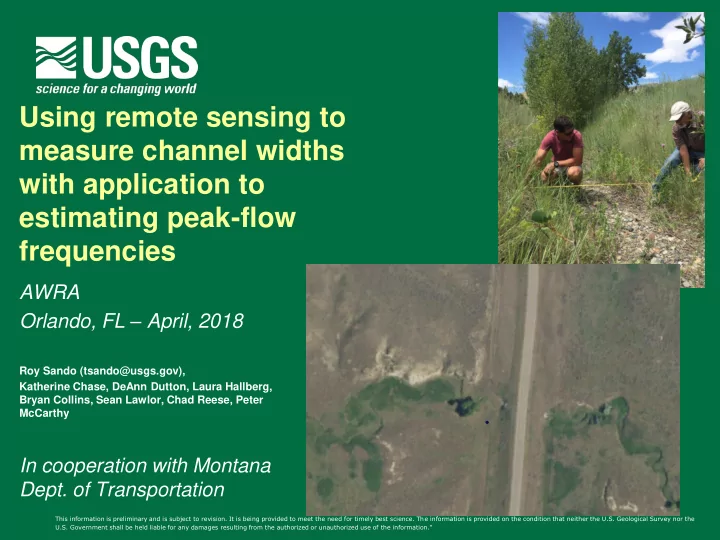

Using remote sensing to measure channel widths with application to estimating peak-flow frequencies AWRA Orlando, FL – April, 2018 Roy Sando (tsando@usgs.gov), Katherine Chase, DeAnn Dutton, Laura Hallberg, Bryan Collins, Sean Lawlor, Chad Reese, Peter McCarthy In cooperation with Montana Dept. of Transportation This information is preliminary and is subject to revision. It is being provided to meet the need for timely best science. The information is provided on the condition that neither the U.S. Geological Survey nor the U.S. Government shall be held liable for any damages resulting from the authorized or unauthorized use of the information."
Outline ▪ Background ▪ Methods ▪ Preliminary results ▪ Conclusions/Limitations
Peak-Flow Frequency Analysis • Annual Exceedance Probabilities ( AEP ) • a.k.a Flood frequency, X-year flood, peak-flow frequency, recurrence intervals • Q is the streamflow discharge value associated with a given AEP. Commonly reported Q AEPs 50% to 0.2% (2-year to 500-year recurrence interval) What about at stream locations that don’t have gaging stations?
Methods for estimating Q AEPs at ungaged locations ▪ Regression analysis ▪ Ordinary, weighted, generalized least squares ▪ Region of Influence ▪ Hydrologic models ▪ Machine learning Explanatory variables needed!!!!
Current Regression Equations ▪ Sando, Sando, McCarthy, and Dutton, 2016 ▪ Regional Regression Equations based on Basin Characteristics ▪ Channel Width-data NOT included
Previous Regression Equations ▪ Parrett and Johnson, 2004 ▪ Included Regression Equations based on Channel Width ▪ Also weighting option for basin characteristics and channel width
Developing Regional Regression Equations using Channel-Width Data ▪ Historical (1970s-1990s) on- site channel-width measurements ▪ New (2017) on-site channel- width measurements ▪ Channel-width measurements from aerial photographs
Why? ▪ Previous studies – can be more reliable ▪ Basin characteristics can be complex ▪ Basin characteristics might predict what could happen ( a priori) ▪ Channel width formed by prevailing streamflow. Show what has happened ( a posteriori)
160 160 Northwest Northwest Foothills 140 140 Percent error 120 Percent error 120 160 Northeast Plains 100 100 140 80 80 Percent error 120 60 60 100 40 40 80 20 20 60 0 0 40 20 0 160 East-Central Plains 140 Percent error 120 100 160 West 80 140 60 Percent error 120 40 100 20 80 0 60 40 20 0 160 Southeast Plains 140 Percent error 120 160 Southwest 100 140 80 Percent error 120 60 100 160 Upper Yellowstone- 40 80 140 Central Mountain 20 60 Percent error 120 0 40 100 20 80 0 60 40 20 0 Preliminary Information-Subject to Revision. Not for Citation or Distribution.
Methods Fieldwork component Remote sensing component
Site locations
Fieldwork 70 locations At each location: ▪ 3 Active channel widths ▪ 3 Bankfull channel widths ▪ Channel bed/bank material ▪ Vegetation
Channel Widths Might be easier to see for ephemeral streams Might be easier to see for perennial streams
Bankfull Channel Width 06177820 Horse Creek Trib near Richey
Remote sensing ▪ 2 independent measurers ▪ 517stations ▪ Natural Color NAIP ▪ July/August 2015 ▪ Parameters ▪ Channel width ▪ Channel type ▪ Vegetation ▪ Channel constraints ▪ Measurer confidence 06024450 Big Hole River bl Big Lake Cr at Wisdom MT
Preliminary Results 2017 Field Measurement (R 2 = 0.92) Historical Field Measurement (R 2 = 0.84) Preliminary Information-Subject to Revision. Not for Citation or Distribution.
Channel types Braided/Depositional Meandering/wide valley Steep/alpine Transitional Undetermined R 2 = .77 R 2 = .77 R 2 = .91 R 2 = .93 R 2 = .59 AIC = 1,794 AIC = 6,436 AIC = 1,621 AIC = 950 AIC = 1,615 Preliminary Information-Subject to Revision. Not for Citation or Distribution.
Vegetation Type Bare dirt Trees Grass Shrubs R 2 = .76 R 2 = .89 R 2 = .80 R 2 = .85 AIC = 625 AIC = 2,319 AIC = 6,679 AIC = 3,229 Preliminary Information-Subject to Revision. Not for Citation or Distribution.
Permanent Vegetation Clarity High clarity Low clarity Medium clarity R 2 = .80 R 2 = .09 R 2 = .82 AIC = 7,318 AIC = 1,575 AIC = 3,315 Preliminary Information-Subject to Revision. Not for Citation or Distribution.
Channel constraint Constrained (road features) Constrained (stabilization) Constrained (natural) Unconstrained Undetermined R 2 = .81 R 2 = .93 R 2 = .93 R 2 = .83 R 2 = .89 AIC = 971 AIC = 45 AIC = 1,310 AIC = 10,150 AIC = 471 Preliminary Information-Subject to Revision. Not for Citation or Distribution.
Subjectivity of site selection Low subjectivity Medium subjectivity High subjectivity R 2 = .82 R 2 = .77 R 2 = .19 AIC = 6,778 AIC = 4,344 AIC = 1,431 Preliminary Information-Subject to Revision. Not for Citation or Distribution.
Preliminary Conclusions ▪ Using aerial photography to measure channel widths might work best for: ▪ Streams that don’t change much with riparian zones comprised of permanent vegetation with clearly visible edges. ▪ Including Lidar derivatives (channel bathymetry, canopy height, channel type, channel migration) could improve estimates
Limitations ▪ Results are preliminary ▪ Changes in channel geometry from natural and anthropogenic factors ▪ Gage locations often at non-ideal locations ▪ Basin sizes vs spatial resolution of imagery ▪ Large and/or recent flood events Questions?
Recommend
More recommend